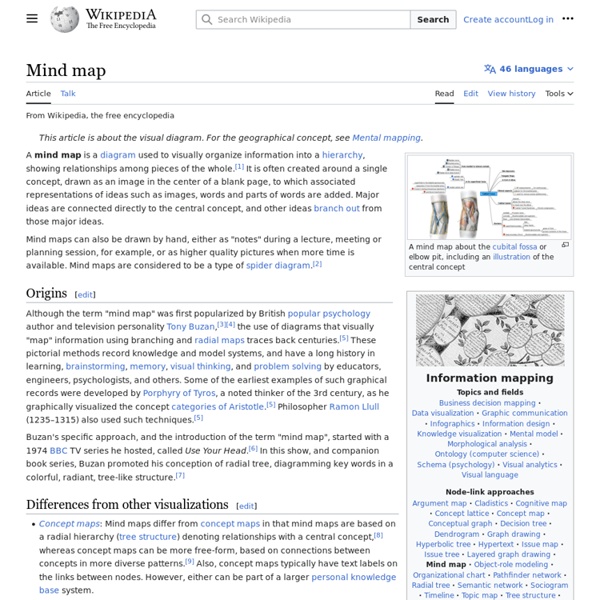Thorp’s E-Books
Below you will find the links to all of the textbooks and textbook resources that are available on-line. If you have lost your username and password see Mrs. Montemayor
Concept map
An Electricity Concept Map, an example of a concept map A concept map or conceptual diagram is a diagram that depicts suggested relationships between concepts.[1] It is a graphical tool that designers, engineers, technical writers, and others use to organize and structure knowledge. A concept map typically represents ideas and information as boxes or circles, which it connects with labeled arrows in a downward-branching hierarchical structure. The relationship between concepts can be articulated in linking phrases such as causes, requires, or contributes to.[2]
18 Free Mind Mapping Tools for Teachers and Students
1- SpiderScribe This is a great mind mapping tool that allows users to easily visualize their ideas by connecting various pieces of information together and create free style maps. It also combines elements like text, images, files, calendar events and geographic locations. 2- EdistormEdistorm is a great web2.0 tool for educators. It allows you to work on your ideas during a structured brainstorming and organize them into sticky notes for others to see .
Mind Maps and Mind Mapping
The human brain is very different from a computer. Whereas a computer works in a linear fashion, the brain works associatively as well as linearly - comparing, integrating and synthesizing as it goes.Association plays a dominant role in nearly every mental function, and words themselves are no exception. Every single word, and idea has numerous links attaching it to other ideas and concepts. Mind Maps™, developed by Tony Buzan are an effective method of note-taking and useful for the generation of ideas by associations. To make a mind map, one starts in the center of the page with the main idea, and works outward in all directions, producing a growing and organized structure composed of key words and key images.
'Smart Clothes' May Use New Touch Screen Fibers In Wearable Computers
By: Jeremy Hsu, InnovationNewsDaily Senior Writer Published: 01/31/2012 10:02 PM EST on InnovationNewsDaily Today's ordinary clothing has the untapped power to become tomorrow's wearable electronics. A Canadian lab has tested special fibers that can help make soft, flexible touch screens and batteries woven directly into the fabrics of modern life. Turning rigid electronic parts into stretchy, smart clothing material has not proven easy. But early ideas have already hinted at practical uses beyond just wearing glowing "Tron" jumpsuits as fashion accessories.
How to use EdPuzzle for differentiation
Check out this great resource for differentiation and the flipped classroom: EdPuzzle. It lets you mark up videos with commentary, crop them for time and embed quizzes. And as an educator, you can see behind-the-scenes exactly how students are engaging with your content, so you can use EdPuzzle for differentiation. Let me walk you through how to get up and running with it.
Knowledge Integration Map
A Knowledge Integration Map (KIM) is a discipline-specific form of concept map. Concept maps are a form of node-link diagram for organizing and representing connections between ideas as a semantic network. KIMs consist of concepts and labeled arrows. Different from traditional concept maps, KIMs divide the drawing area into discipline-specific areas, for example in biology into genotype/phenotype. Overview[edit]
iMindMap - Basic
People within organisations and educational institutions around the world are already seeing the benefits of iMindMap – start discovering them yourself today. “Your Mind Mapping software has transformed our business & become a part of our cultural DNA.” Wheaton Wealth Partners, USA
Visual Thinking + Synthesis
Photo by Ken Yeung I really enjoy talking complex subjects, processes or business problems and boiling them down to their core essence. This is becoming known as the process of "Visual Thinking". I use visual metaphors and storytelling to do this. My style of visual thinking is immediately recognizable and has helped me build a strong following of influential professionals who use my visuals in their own presentations and documents. A comprehensive archive of my visuals can be found on Flickr (please credit if you use them) and if you are interested in Visual Thinking as a discipline, you can visit VizThink for additional resources.
Flex and wear: These screens can go anywhere!
Editor's Note: Karyn Lu is Turner Broadcasting's manager of New Media Insights & Inspiration. Each week, she scouts out amazing innovations, cutting edge technology and, well, just really awesome stuff and shares them right here. Before it goes mainstream, it's going to be one of her favorite 5 Things From The Future! 1.
Dictionary Game
By Claire Owen Age Range: 7 to 11 Each child has a dictionary (or partnered if resources are limited). The teacher randomly chooses a word and the children race to find it in their dictionaries. The first child to find it reads out the definition. They then get to chose the next word to search for! This is great fun and creates real competition between the children to be the first to find the word.
Creating Concept Maps
A concept map is a picture of our understanding of something. It is a diagram illustrating how sets of concepts are related. Concept maps are made up of webs of terms (nodes) related by verbs (links) to other terms (nodes). The purpose of a concept map is to represent (on a single visual plane) a person’s mental model of a concept.
Using FreeMind
Using FreeMind In this tutorial, we'll look at creating a mind map. Just to remind you, a mind map is a hierarchical set of nodes, connected together by edges (lines), which are displayed as a graphical map. The guide's choice of mind mapping software is FreeMind, an open source program, by Jörg Müller. If you haven't already downloaded and installed this program, the guide's article FreeMind – Mind Mapping will show you what to do.



